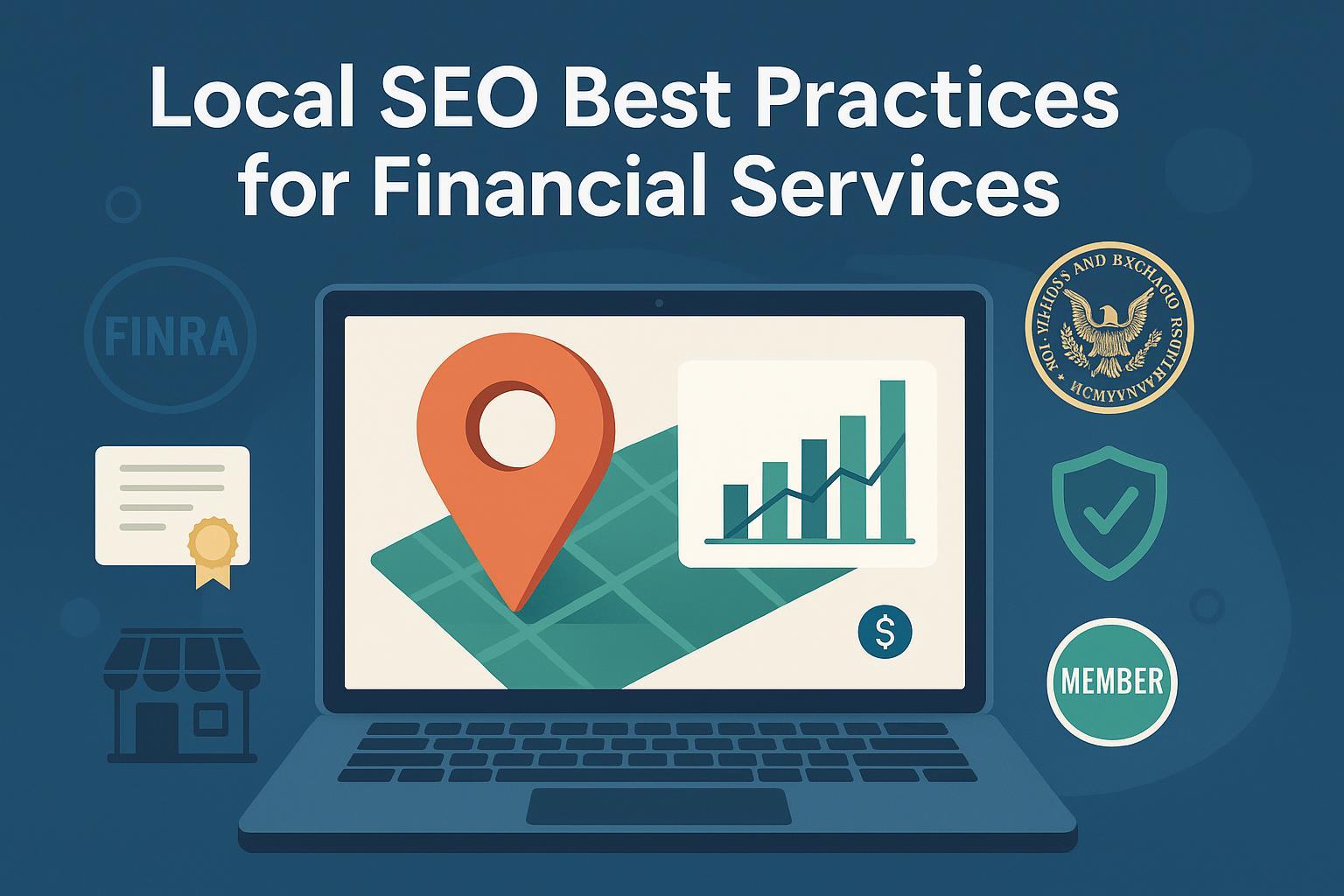Leveraging Local SEO for Financial Services: Strategies to Attract Local Clients

“In today’s regulatory-heavy and highly competitive finance sector, mastering local SEO isn’t just a growth lever—it’s a compliance and trust necessity.”
Introduction: Why Local SEO Matters Now More Than Ever for Financial Services
With prospective clients searching for “financial advisor near me” or “tax accountant [city],” local SEO is the new battleground for financial service providers. But unlike most industries, finance comes with regulatory hurdles—thanks to SEC, FINRA, and AICPA—that make both visibility and compliance critical. Evolving Google algorithms, recent shifts in testimonial advertising rules, and the increasing use of trust signals by clients mean that only the most robust and compliant local SEO strategies will drive local client acquisition and build sustainable authority.
This best practices guide synthesizes proven, compliance-oriented local SEO tactics tailored specifically for U.S. financial advisors, CPA firms, and wealth managers in 2024. Each recommendation comes with actionable steps, regulatory context, tools, and recent industry results.
Table of Contents
- Claim and Optimize Your Google Business Profile (GBP) Compliantly
- Ensure NAP Consistency and Structured Citations
- Build Local, Regulation-Safe Trust Signals
- Develop Geo-Targeted, Regulatory-Compliant Landing Pages
- Activate Review and Testimonial Management—Within Legal Limits
- Pursue Authority-Building, Locally-Relevant Backlinks
- Audit Technical and Mobile Performance for Compliance
- Always Align With Financial Advertising Regulations
- Local SEO Self-Audit: Checklist
1. Claim and Optimize Your Google Business Profile (GBP) Compliantly
What/Why: Google Business Profile is the engine of local search—especially for Map Pack rankings. For financial firms, it’s also a legal asset.
How:
- Claim and verify your GBP at Google Business Profile.
- Ensure all information—Name, Address, Phone (NAP)—matches your regulated listings and disclosures.
- Use industry keywords (e.g., “wealth management,” “retirement planning [city]”) within compliance.
- Add high-quality imagery: Interiors/exteriors, staff headshots, and trust badges (certifications, awards). Avoid stock images and misleading content, per FINRA guidance.
- Regularly post content updates about tax seasons, new regulations, and community events—this shows active expertise and regulatory alignment.
- Review all GBP posts and images for regulatory adherence before publishing.
Impact: Firms optimizing GBP typically see a 30–40% improvement in Map Pack presence and call volume (SiegeMedia).
2. Ensure NAP Consistency and Structured Citations
What/Why: Inconsistent Name/Address/Phone data can not only lose rankings—it can trigger regulatory confusion and consumer distrust.
How:
- Audit all online mentions (website, directories, chamber listings, licensing boards) for exact NAP matches.
- Use tools like Moz Local or BrightLocal to identify and fix inconsistencies.
- For multi-advisor/branch firms: Maintain a master citation sheet and designate a compliance officer to approve NAP/citation changes before publication.
- Implement Local Business structured data (schema) with regulatory credentials where possible.
Impact: Firms see average ranking lifts of 10–20% following comprehensive citation cleanups, based on aggregated industry benchmark reports.
3. Build Local, Regulation-Safe Trust Signals
What/Why: Local prospects—and Google—care just as much about proof of trust as keywords. For finance, this means credentials and regulatory status on display.
How:
- Prominently display FINRA, SEC, AICPA, or CFP credentials on your website and GBP.
- Use third-party membership badges, awards (local business lists, BBB), and local/industry press features.
- Include bios with qualifications and links to your advisor regulatory records (e.g., FINRA’s BrokerCheck).
- Write content and GBP descriptions emphasizing regulatory membership and compliance (not product promises).
- Where allowed, mention privacy protocols and data safeguards to reinforce client protection.
Impact: Firms highlighting credentials report higher engagement and trust, with improved click-throughs from local search.
4. Develop Geo-Targeted, Regulatory-Compliant Landing Pages
What/Why: Industry studies show that firms with targeted local pages for each service area outperform generic sites—if every statement is compliance-approved.
How:
- Create a subpage for each town/city/area served (e.g., “Retirement Planning in Austin, TX”).
- Incorporate locally relevant keywords and community events, but avoid testimonials or performance claims unless explicitly permitted by your regulator (SEC’s 2021 update).
- Pre-clear all content with internal or external compliance reviewers.
- Link these pages to your GBP, regional business profiles, and chamber sites.
Impact: Case studies show location landing pages can drive 40%+ increases in local organic visibility and lead volume (HeiPro Digital).
5. Activate Review and Testimonial Management—Within Legal Limits
What/Why: The 2021 SEC rule update allows more flexibility in the use of testimonials for RIAs, but strict conditions apply. Mishandled review solicitation can lead to violations.
How:
- Confirm exactly what review/testimonial practices are allowed under your regulator (see SEC FAQ, FINRA Guidance)—this may differ for RIAs and broker-dealers.
- Use platforms like Whitespark or Trustpilot to manage review requests, disclosures, and archiving.
- Never offer incentives for reviews. Make all solicitation and use of testimonials fully transparent.
- Disclose required legal wording with any featured testimonials (e.g., “Clients were not compensated… Results not guaranteed…”).
- Remove or flag reviews that violate privacy or compliance policies.
Impact: Financial firms using a compliant, transparent review approach report 20–30% more inbound calls and higher local search trust.
6. Pursue Authority-Building, Locally-Relevant Backlinks
What/Why: Quality local backlinks help validate your presence—so long as you avoid link schemes and maintain disclosures.
How:
- Pursue citations and backlinks from local news, business groups, associations, and non-profit partners.
- Submit for inclusion in legitimate local directories with compliance review.
- Guest post on local finance or community blogs—always add regulatory disclosures if discussing investment/tax strategy.
- Avoid paid or non-transparent links.
Impact: Local backlinks drive both ranking improvement and targeted referral traffic, as shown by independent agency data.
7. Audit Technical and Mobile Performance for Compliance
What/Why: Slow, broken, or insecure sites erode trust and may trigger compliance red flags.
How:
- Audit your site monthly with Screaming Frog, Ahrefs, or SEMrush.
- Ensure your site is HTTPS secure and mobile-optimized (test with Google Mobile-Friendly Test).
- Fix broken links, ensure all disclosures are visible everywhere (including mobile), and load all compliance documents as accessible PDFs.
- Periodically review ADA (accessibility) compliance.
Impact: Technically sound sites see lower bounce rates and higher engagement, and reduce legal risk for digital disclosures.
8. Always Align With Financial Advertising Regulations
What/Why: Non-compliance can mean removal, fines, or litigation. Online content must pass both search and regulatory tests.
How:
- Familiarize your marketing/compliance team with the latest SEC, FINRA, and AICPA advertising rules.
- Conduct pre-publication content audits and maintain documentation for every page and GBP change.
- For multi-location or multi-advisor firms: Implement standardized, reviewed templates and a change log for all web and GBP edits.
- Subscribe to regulator bulletins and set quarterly compliance review meetings.
Impact: Proactive compliance reduces the risk of algorithmic and legal penalties—protecting both firm reputation and client trust.
9. Local SEO Self-Audit: Compliance Checklist
Download this checklist and schedule a quarterly review. Each step should be reviewed by compliance or legal if possible.
- [ ] Is GBP fully claimed, verified, and all fields complete?
- [ ] Do online NAP citations match exactly, everywhere?
- [ ] Are all location and staff credentials/disclosures visible?
- [ ] Are all website and GBP updates pre-cleared by compliance?
- [ ] Are client reviews/testimonials used according to the latest SEC/FINRA rules?
- [ ] Do local backlinks and citations avoid non-transparent, paid link schemes?
- [ ] Does your site pass technical and ADA/mobile checks?
- [ ] Are all local pages/landing pages compliant with regulatory guidelines?
- [ ] Are you subscribed to updates from SEC/FINRA/AICPA?
Conclusion: Compliant Local SEO Drives Trust and Qualified Growth
The best local SEO for financial services fuses technical proficiency, regulatory rigor, and authentic trust-building. By systematically executing these practices—and routinely updating your approach with compliance and industry input—you’ll not only boost your search visibility, but also power your reputation as a trusted local authority. Start today by downloading and using the checklist above, assigning clear roles for compliance review, and mapping your next quarter’s local strategy with care.
For more regulatory guidance, see the following resources:
Stay informed—compliant growth is sustainable growth.

